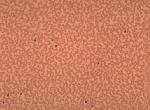
 | The normal peripheral blood is appears homogenous using a low magnification. Most cells are RBCs, it is easy to find WBCs, but you won't see them in every field. |

| This is the most frequent form of WBCs in a normal peripheral
blood film. The cytoplasmatic granules are fine, have no distinct
color, the nucleus is segmented into 3-5 parts. Frequency: 50-70%
|

| The nucleus of a neutrophilic band is long, narrow, band-like.
Frequency: 2-8% |

|
The nucleus of a neutrophilic juvenile cell is bean-shaped.
This is the youngest cell type in the granulocyte series,
that can appear in the normal peripheral blood smear.
Frequency: 0-1% |

| The lymphocyte is a round cell about the size of an RBC, with
a round nucleus and very little of cytoplasm. Frequency: 20-40% |

| The monocyte is a cell with grey-blue cytoplasm, somewhat larger than a granulocyte. The nucleus frequently does not flatten out and may bend over itself in the smear. Frequency: 2-6%. |